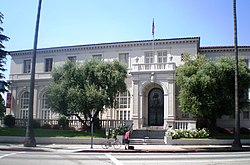Wilshire Ebell Theatre
|
Ebell of Los Angeles
|
|

Ebell of Los Angeles, Wilshire frontage
|
|
| Location | 743 S. Lucerne Boulevard, Los Angeles, California |
|---|---|
| Coordinates | 34°3′42″N 118°19′27″W / 34.06167°N 118.32417°WCoordinates: 34°3′42″N 118°19′27″W / 34.06167°N 118.32417°W |
| Built | 1927 |
| Architect | Hunt, Sumner P.; Schofield Engineering & Construction |
| Architectural style | Italian Renaissance |
| NRHP Reference # | 94000401 |
| LAHCM # | 250 |
| Significant dates | |
| Added to NRHP | May 6, 1994 |
| Designated LAHCM | 1982-08-25 |
The Ebell of Los Angeles is a women's club housed in a complex in the Mid-City section of Wilshire, Los Angeles, California. It includes a clubhouse building and the renowned 1,270-seat Wilshire Ebell Theatre.
The complex has been owned and operated since 1927 by the Ebell of Los Angeles women's club, which was formed in Los Angeles in 1894 or 1897. Since 1927, the Wilshire Ebell Theatre has hosted musical performances and lectures by world leaders and top artists. Among other events, the Ebell was the site of aviator Amelia Earhart's last public appearance before attempting the 1937 around-the-world flight during which she disappeared. It is also the place where Judy Garland was discovered while performing as Baby Frances Gumm in the 1930s.
Ebell of Los Angeles was formed as a women's club in 1894, based on the principles and teachings of Adrian Ebell, a pioneer in women's education and organizing women's societies in the late 19th century. Harriet Williams Russell Strong was a founder of the club, serving as its president for three consecutive terms. The minutes of the first meeting of Ebell of Los Angeles identify its purpose "to interest women in the study of all branches of literature, art and science and the advancement of women in every branch of culture." The club adopted as its motto, "I will find a way or make one -- I serve."
Over the years, the group has conducted classes, and hosted lectures and seminars, on topics including psychology, parliamentary law, travel, literature, music, gardening and science. Even before moving to its current quarters, it actively promoted the arts, as when from May 23 to July 25, 1919 it sponsored a marathon ten-week series of chamber music recitals by the Zoellner Quartet.
In 1923, the group announced plans to build a new clubhouse and theater west of downtown on Wilshire Boulevard. Before construction began, the lot at Wilshire Boulevard and Shatto Place had appreciated in value and was sold for a profit; a new lot at the corner of Wilshire Boulevard and Lucerne was purchased in 1925.
The group commissioned architect Sumner P. Hunt of Hunt & Burns to design the new facility, which was designed in an Italian style with plaster facing and Italian clay tile roofing. The new facilities consisted of multiple structures covering a site 160 × 450 feet, surrounding a 65 × 120 foot patio area. The new facilities included a new 1,300-seat auditorium at the rear of the property facing 8th Street. The two-story structure facing Wilshire Boulevard houses the group's clubhouse, including a large lounge, art salon, and dining room. The dining room opens to a tile-roofed colonnade walkway and fountain.
...
Wikipedia
